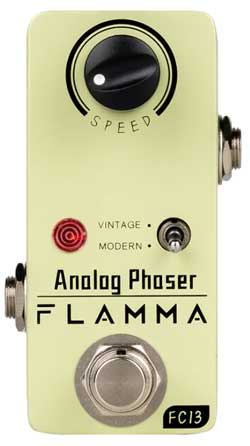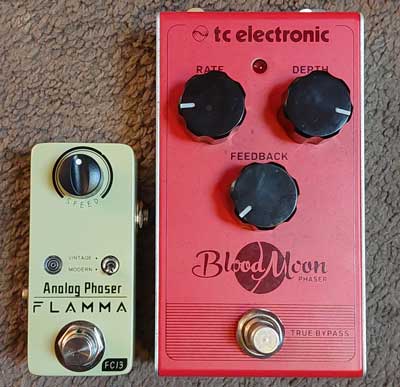The FLAMMA FC13 is a low-cost mini phaser pedal and in this review, I’ll give you a thorough look at whether you might want one on your pedalboard.
Check out my Ultimate Guide to Phaser Pedals to learn more about phasers and alternative pedals.
FLAMMA FC13 Phaser Pedal Features
Here are the main features of the FC13 Phaser Pedal:
- Mono input/output
- Modern/Vintage toggle switch
- Speed knob
- External Power Supply Only (not included)
- 5 mA power draw (9V)
- Dimensions: 82 x 37 x 52 mm
Check out the current price and full details of the FC13 Phaser here (link to Amazon).

As you can see from the above photo, the FC13 is a tiny pedal. It’s a sturdy aluminum shell with a single footswitch, LED, knob, and toggle switch.
FLAMMA FC13 Phaser Ease of Use
Phasers are typically simple pedals to use. The most famous phaser pedal, the MXR Phase 90, only has one knob for speed.
The FC13 has a single knob for speed and a toggle switch to change between vintage and modern modes.
So the FC13 has slightly more flexibility than many other phaser pedals, but it’s still a very simple pedal to you.
You set the phaser speed to your liking using the speed knob, then choose between vintage or modern mode depending on the type of tone you prefer (covered later).
If you haven’t used a phaser before, check out my Guitar Effects Course to learn everything you would want to know about phasers, flangers, other modulation effects and every other common guitar effect.
FLAMMA FC13 Phaser Sound Quality
I’m extremely happy with how this phaser sounds. A phaser is one of my favorite effects because a good phaser can add so much life and attitude to your playing.
Sometimes phasers overpower the original tone or change it so much that you can’t use it in subtle ways. Other times, the phaser doesn’t cut through enough. The FLAMMA FC13 hits a sweet spot where it can be used in subtle ways or for more intense effects.
Here’s a clean guitar tone first without the phaser, then with the phaser turned on with a slow speed in vintage mode:
The above amp tone is produced with the “Sparkling Clean” amp model in TONEX (link to my review), which is based on a Fender 65 Deluxe Reverb.
As you can hear, the pedal does a good job of keeping the volume consistent with and without the phaser. The phaser is also quite transparent in that it keeps the main tone intact. Some phaser pedals I’ve tried out completely overrun the main signal, but this one doesn’t.
Here’s some loose jamming with a neck humbucker and the phaser set to medium speed in vintage mode:
At this speed, you can hear the swirling movement of the phaser gradually change, but it’s not distracting or over-the-top.
Here’s the same phaser speed in modern mode:
In person, there’s a clear difference between the vintage and modern modes.
Here’s the modern mode using single-coil pickups:
While I personally prefer the sound of this phaser with my humbuckers, the glassy and bell-like chime from single coil pickups works extremely well with this phaser.
Here’s the phaser speed turned up slightly in vintage mode:
Then again with the speed turned up to about 75%:
You can hear the swirling of the phaser in that first sustained note and how fast it is compared to the other clip. For me, this is where phasers become less of a background effect and more of an in-your-face effect that stands out.
Of course, when testing out a pedal you must crank things up to 100%. So here’s the phaser in vintage mode at full speed:
If you’ve never used a phaser before, cranking the speed up is a great way to get an interesting warbling/vibrato/tremolo-like effect. It works best when you play with lots of sustained notes and chords.
Here’s the full-speed phaser in modern mode:
I’m playing natural harmonics here to showcase the swirling and warbly sound you get when you crank the speed up.
Here’s a drive tone first with the phaser turned off, then again with it turned on in the modern mode at a slow speed:
As you might imagine, the type of amp you use plays a massive role in how you hear this phaser. A modern high gain amp will make the phaser sound completely different than what you would hear in a vintage tube amp.
I’m using the “Creamy Brit” amp model in TONEX (link to my review), which is based on an Orange OR120. I feel this amp does a good job at showcasing the phaser without completely stomping on it with gain.
You might have noticed in the above clip that I really dig my pick into the strings when using the phaser. Some effects make you change the way you play and phaser is one of them. There are some things that are a lot of fun to do with a phaser such as digging the pick in, repeating notes, palm-muting, tapping, or legato.
In this clip, I wanted to showcase how the phaser slightly changes the tone and how the slow shifting of the phaser can add something interesting to your playing:
When you switch between playing with and without the phaser, it becomes obvious how much fun the phaser is to jam with.
Here’s a short clip of random jamming with medium gain and a medium phaser speed set to modern mode:
A phaser can be quite expressive and a great tool for creativity and inspiration. While testing this pedal out, I saved quite a few licks and ideas on my TC Electronic WireTap Riff Recorder.
You know you’ve got a great pedal when you find that time has slipped away and you’ve been jamming for hours instead of working. So it’s safe to say I’m happy with how this pedal sounds.
Vintage vs Modern
The FC13 has a toggle switch to choose between two modes: vintage or modern.
The vintage mode has a warmer sound and is likely a 2-stage phaser similar to the MXR Phase 45.
The modern mode has a brighter and deeper sound which is likely a 4-stage phaser similar to the MXR Phase 90.
Here’s a short clip of the FC13 in the vintage mode first, then the same part played with the modern mode:
Both clips use the same speed setting and I kept my guitar controls the same, so the only difference you hear is from the phaser pedal.
If the difference is hard to hear in this clip, it’s very obvious in person. The modern mode feels bigger, fuller, and clearer. While I enjoy using the vintage mode, I find that I’m quite happy leaving the pedal set to the modern mode. The phaser sweeps feel deeper without feeling distracting.
Overall Impressions of the FLAMMA FC13 Phaser Pedal
FLAMMA kindly sent me a few pedals to try out, and at first, I wasn’t expecting much from the FC13.
I’ve tried quite a few budget pedals from other brands and have been regularly disappointed. Some brands use the tiny pedal size for their cheapest pedals and they’re often junk circuits that don’t sound good.
The FC13 doesn’t fit that category and truly impressed me from the moment I turned it on. I ran a side-by-side comparison with another budget phaser pedal, the TC Electronic Blood Moon, and the FC13 was a clear winner.
While I like the extra controls offered by the Blood Moon Phaser, it doesn’t sound as good as the FC13. Not only is the FC13 a far better-sounding phaser pedal, but the small form factor makes it far easier for me to recommend it. The FC13 is also far cheaper than the Blood Moon Phaser.
Just look at the size difference:

If you’re unsure how much you will use a phaser, it makes sense to use a compact pedal like the FC13.
The tiny size of this pedal is ideal for a phaser. You can tuck it away in the corner of your pedalboard while leaving plenty of room for larger pedals that require more knobs and controls.
I’ve spent quite a few hours just jamming and having fun playing with the FC13.
The FLAMMA FC13 now has a permanent place on my pedalboard, which is quite the achievement for such a low-cost pedal. There are some pedals on my pedalboard that cost 10x what the FC13 costs, yet I’m just as happy with this pedal.
If you’re curious about adding a phaser to your rig but don’t like the idea of spending a lot of money on the most popular options, I definitely recommend the FLAMMA FC13.
Check out the current price and full details of the FC13 Phaser here (link to Amazon).
How to Get the Most Out of the FLAMMA FC13 Phaser Pedal
Here are a few things you can do to get the most out of the FLAMMA FC13 or any other phaser pedal:
Check out my Guitar Effects Course
I created my Guitar Effects Course to help guitarists learn to identify effects by ear, learn the differences between similar-sounding effects (eg: phaser vs flanger), and to learn how to use effects in combination in a rig.
If you want to get the most out of any pedal you buy, you might want to learn more about the effect in my course.
Listen to Songs Using Phaser Pedals
Hearing how different guitarists use phaser pedals can give you ideas on how to use your phaser pedal.
Here are some well-known songs that feature a phaser pedal:
- Eruption – Van Halen
- Little Wing – Jimi Hendrix
- Paranoid Android – Radiohead
- Soma – Smashing Pumpkins
- Shattered – The Rolling Stones
Have a listen to these songs and see if you can replicate the tone with your own rig (or get close enough). Listen carefully for the speed of the phaser to try and match it with your pedal.
Check out these Useful Guides
Here are a few useful guides worth reading:
As the FC13 requires an external power supply, I recommend reading the two above guides on powering your pedals to see what options you have.
Related Guides and Lessons:

























